Energy, Exergy and Environmental Analysis of ORC Waste Heat Recovery from Container Ship Exhaust Gases Based on Voyage Cycle
Abstract
:1. Introduction
2. System Description
2.1. The M/E and Waste Heat Source of EG Information
2.2. Working Fluids Selection
2.3. Voyage Cycle Overview
3. Thermodynamic Analysis of ORC System
3.1. Thermodynamic Model
3.2. Assumptions and Validation
4. Results and Discussion
4.1. Net Power and the Exhaust Outlet Temperature
4.2. Exergy Flow Losses and Exergy Efficiency
4.3. Working Fluids Performance during the Voyage Cycle
4.4. Environmental Performance
5. Conclusions
Author Contributions
Funding
Institutional Review Board Statement
Informed Consent Statement
Data Availability Statement
Conflicts of Interest
Nomenclature
| Acronyms | Subscripts | ||
| BSFC | Brake specific fuel consumption | boil | Boiling process |
| CSR | Continuous service rating | con | Condenser |
| C | Carbon factor | exp | Expander |
| EG | Exhaust gas | eva | Evaporation process |
| GWP | Global warming potential | gas | Exhaust gas |
| MCR | Maximum Continuous Power | PPTD | Pinch point temperature difference |
| M/E | Main engine | pre | Preheating process |
| ORC | Organic Rankine cycle | the | Thermal |
| ODP | Ozone depletion potential | tot | Total |
| RECP | Ratio between evaporation pressure and critical pressure | wf | Working fluid |
| R | Ratio | fs | Fuel saving |
| tEbT | Temperature of exhaust gas before turbocharger | rp | Recovered power |
| tEaT | Temperature of exhaust gas after turbocharger | ||
| H | Hour | ||
| Nomenclature | Greek symbols | ||
| Cp | Specific heat capacity (kJ/(kg·K)) | η | Efficiency |
| Exergy (kW) | |||
| I | Exergy loss (kW) | ||
| h | Specific enthalpy (kJ/kg) | ||
| ṁ | Mass flow rate (kg/s) | ||
| P | Pressure (kPa) | ||
| Q | Heat power (kW) | ||
| S | Entropy (kJ/K) | ||
| T | Temperature (K) | ||
| W | Power (kW) | ||
| M | Mass (t) | ||
Appendix A
| Components | Energy | Exergy | Isentropic Efficiency |
|---|---|---|---|
| EG | |||
| Evaporator preheating | |||
| Evaporator boiling | |||
| Expander | |||
| Condenser | |||
| Cooling water | |||
| Pump |
| Load | 90% Load | 85% Load | 80% Load | 30% Load | ||||||||
|---|---|---|---|---|---|---|---|---|---|---|---|---|
| working fluid | Cyclohexane | Benzene | Toluene | Cyclohexane | Benzene | Toluene | Cyclohexane | Benzene | Toluene | Cyclohexane | Benzene | Toluene |
| evap (kPa) | 1033 | 1038 | 655 | 945 | 955 | 605 | 922 | 932 | 592 | 1248 | 1235 | 769 |
| conp (kPa) | 102 | 102 | 102 | 102 | 102 | 102 | 102 | 102 | 102 | 102 | 102 | 102 |
| exp ratio | 10.13 | 10.18 | 6.42 | 9.26 | 9.36 | 5.93 | 9.04 | 9.14 | 5.80 | 12.24 | 12.11 | 7.54 |
| Rrp | 4.7% | 4.6% | 2.9% | 4.4% | 4.2% | 2.7% | 4.4% | 4.2% | 2.7% | 8% | 7.7% | 5% |
| RECP | 25% | 21% | 16% | 23% | 19% | 14.8% | 23% | 19% | 14% | 31% | 25% | 19% |
| Net power (kW) | 605.8 | 584.1 | 373.4 | 530.5 | 513.2 | 323.3 | 500 | 484.6 | 303.9 | 285 | 272.7 | 178.7 |
| EG outlet tem (K) | 389.7 | 402.7 | 429.3 | 391.6 | 403.3 | 429.4 | 392.1 | 403.4 | 429.5 | 384.9 | 401 | 428.4 |
| Thermal efficiency | 13.8% | 14.6% | 11.4% | 13.4% | 14% | 11% | 13.3% | 14% | 11% | 14.6% | 15.4% | 12.3% |
| Mass flow rate (kg/s) | 8.47 | 7.79 | 6.85 | 7.76 | 7.13 | 6.22 | 7.42 | 6.81 | 5.93 | 3.64 | 3.35 | 2.99 |
| Parameters | Fluid | Changjiangkou–Shanghai | Shanghai–Ningbo | Ningbo–Vung Tau | Vung Tau–Saigon | Saigon–Laem chabang | Laem chabang–Guangzhou | Guangzhou–Shanghai |
|---|---|---|---|---|---|---|---|---|
| Expander ratio | Cyclohexane | 12.24 | 9.04 | 10.13 | 9.04 | 9.26 | 9.04 | 9.26 |
| Benzene | 12.11 | 9.14 | 10.18 | 9.14 | 9.36 | 9.14 | 9.36 | |
| Toluene | 7.54 | 5.8 | 6.42 | 5.8 | 5.93 | 5.8 | 5.93 | |
| Mass flow rate (kg/s) | Cyclohexane | 3.64 | 7.42 | 8.47 | 7.42 | 7.76 | 7.42 | 7.76 |
| Benzene | 3.35 | 6.81 | 7.79 | 6.81 | 7.13 | 6.81 | 7.13 | |
| Toluene | 2.99 | 5.93 | 6.85 | 5.93 | 6.22 | 5.93 | 6.22 | |
| Thermal efficiency (%) | Cyclohexane | 14.6 | 13.3 | 13.8 | 13.3 | 13.4 | 13.3 | 13.4 |
| Benzene | 15.4 | 14 | 14.6 | 14 | 14.1 | 14 | 14.1 | |
| Toluene | 12.3 | 11 | 11.5 | 11 | 11.1 | 11 | 11.1 | |
| Voyage Time (h) | Cyclohexane | 28.9 | 10.5 | 104.4 | 4.1 | 44 | 110.3 | 66.7 |
| Benzene | 28.9 | 10.5 | 104.4 | 4.1 | 44 | 110.3 | 66.7 | |
| Toluene | 28.9 | 10.5 | 104.4 | 4.1 | 44 | 110.3 | 66.7 | |
| Net power (kW) | Cyclohexane | 285.03 | 500.41 | 605.75 | 500.41 | 530.48 | 500.41 | 530.48 |
| Benzene | 272.73 | 484.57 | 584.14 | 484.57 | 513.24 | 484.57 | 513.24 | |
| Toluene | 178.79 | 303.89 | 373.45 | 303.89 | 323.32 | 303.89 | 323.32 | |
| Fuel saving (tons) | Cyclohexane | 1.4 | 0.87 | 10.64 | 0.34 | 3.89 | 9.12 | 5.90 |
| Benzene | 1.34 | 0.84 | 10.26 | 0.33 | 3.76 | 8.83 | 5.71 | |
| Toluene | 0.88 | 0.53 | 6.56 | 0.21 | 2.37 | 5.54 | 3.59 | |
| CO2 (tons) | Cyclohexane | 4.33 | 2.69 | 32.99 | 1.05 | 12.06 | 28.27 | 18.29 |
| Benzene | 4.15 | 2.61 | 31.82 | 1.02 | 11.67 | 27.37 | 17.69 | |
| Toluene | 2.72 | 1.63 | 20.34 | 0.64 | 7.35 | 17.17 | 11.14 |
References
- Zhu, L. A questionnaire based study on the status quo and future action over the regulation of marine greenhouse gas emissions in Hong Kong. Mar. Policy 2022, 145, 105278. [Google Scholar] [CrossRef]
- IMO Marine Environment Protection Committee (MEPC 80). Available online: https://www.imo.org/en/MediaCentre/MeetingSummaries/Pages/MEPC-80.aspx (accessed on 3 July 2023).
- Mahmoudi, A.; Fazli, M.; Morad, M.R. A recent review of waste heat recovery by Organic Rankine Cycle. Appl. Therm. Eng. 2018, 143, 660–675. [Google Scholar] [CrossRef]
- Mondejar, M.E.; Andreasen, J.G.; Pierobon, L.; Larsen, U.; Thern, M.; Haglind, F. A review of the use of organic Rankine cycle power systems for maritime applications. Renew. Sustain. Energy Rev. 2018, 91, 126–151. [Google Scholar] [CrossRef]
- Di Battista, D.; Di Bartolomeo, M.; Cipollone, R. Full energy recovery from exhaust gases in a turbocharged diesel engine. Energy Convers. Manag. 2022, 271, 116280. [Google Scholar] [CrossRef]
- Baldi, F.; Larsen, U.; Gabrielii, C. Comparison of different procedures for the optimisation of a combined Diesel engine and organic Rankine cycle system based on ship operational profile. Ocean. Eng. 2015, 110, 85–93. [Google Scholar] [CrossRef]
- Choi, B.C.; Kim, Y.M. Thermodynamic analysis of a dual loop heat recovery system with trilateral cycle applied to exhaust gases of internal combustion engine for propulsion of the 6800 TEU container ship. Energy 2013, 58, 404–416. [Google Scholar] [CrossRef]
- Yang, M.-H.; Yeh, R.-H. Thermodynamic and economic performances optimization of an organic Rankine cycle system utilizing exhaust gas of a large marine diesel engine. Appl. Energy 2015, 149, 1–12. [Google Scholar] [CrossRef]
- Mat Nawi, Z.; Kamarudin, S.K.; Sheikh Abdullah, S.R.; Lam, S.S. The potential of exhaust waste heat recovery (WHR) from marine diesel engines via organic rankine cycle. Energy 2019, 166, 17–31. [Google Scholar] [CrossRef]
- Zhang, X.; Wang, X.; Cai, J.; He, Z.; Tian, H.; Shu, G.; Shi, L. Experimental study on operating parameters matching characteristic of the organic Rankine cycle for engine waste heat recovery. Energy 2022, 244, 122681. [Google Scholar] [CrossRef]
- Gürgen, S.; Altın, İ. Novel decision-making strategy for working fluid selection in Organic Rankine Cycle: A case study for waste heat recovery of a marine diesel engine. Energy 2022, 252, 124023. [Google Scholar] [CrossRef]
- El Geneidy, R.; Otto, K.; Ahtila, P.; Kujala, P.; Sillanpää, K.; Mäki-Jouppila, T. Increasing energy efficiency in passenger ships by novel energy conservation measures. J. Mar. Eng. Technol. 2017, 17, 85–98. [Google Scholar] [CrossRef]
- Lümmen, N.; Nygård, E.; Koch, P.E.; Nerheim, L.M. Comparison of organic Rankine cycle concepts for recovering waste heat in a hybrid powertrain on a fast passenger ferry. Energy Convers. Manag. 2018, 163, 371–383. [Google Scholar] [CrossRef]
- WIN GD. WinGD’s General Technical Data (GTD). Available online: https://www.wingd.com/en/engines/general-technical-data-(gtd)/ (accessed on 15 September 2023).
- Lemmon, E.W.; Huber, M.L.; McLinden, M.O. NIST Standard Reference Database 23: Reference Fluid Thermodynamic and Transport Properties-REFPROP, Version 9.1; National Institute of Standards and Technology: Gaithersburg, MD, USA. Available online: https://tsapps.nist.gov/publication/get_pdf.cfm?pub_id=912382 (accessed on 21 October 2023).
- Yağlı, H.; Koç, Y.; Kalay, H. Optimisation and exergy analysis of an organic Rankine cycle (ORC) used as a bottoming cycle in a cogeneration system producing steam and power. Sustain. Energy Technol. Assess. 2021, 44, 100985. [Google Scholar] [CrossRef]
- Kocaman, E.; Karakuş, C.; Yağlı, H.; Koç, Y.; Yumrutaş, R.; Koç, A. Pinch point determination and Multi-Objective optimization for working parameters of an ORC by using numerical analyses optimization method. Energy Convers. Manag. 2022, 271, 116301. [Google Scholar] [CrossRef]
- Lai, N.A.; Wendland, M.; Fischer, J. Working fluids for high-temperature organic Rankine cycles. Energy 2011, 36, 199–211. [Google Scholar] [CrossRef]
- Bellos, E.; Tzivanidis, C. Investigation of a hybrid ORC driven by waste heat and solar energy. Energy Convers. Manag. 2018, 156, 427–439. [Google Scholar] [CrossRef]
- Özahi, E.; Tozlu, A.; Abuşoğlu, A. Thermoeconomic multi-objective optimization of an organic Rankine cycle (ORC) adapted to an existing solid waste power plant. Energy Convers. Manag. 2018, 168, 308–319. [Google Scholar] [CrossRef]
- Siddiqi, M.A.; Atakan, B. Alkanes as fluids in Rankine cycles in comparison to water, benzene and toluene. Energy 2012, 45, 256–263. [Google Scholar] [CrossRef]
- Song, C.; Gu, M.; Miao, Z.; Liu, C.; Xu, J. Effect of fluid dryness and critical temperature on trans-critical organic Rankine cycle. Energy 2019, 174, 97–109. [Google Scholar] [CrossRef]
- Zhai, H.; Shi, L.; An, Q. Influence of working fluid properties on system performance and screen evaluation indicators for geothermal ORC (organic Rankine cycle) system. Energy 2014, 74, 2–11. [Google Scholar] [CrossRef]
- Zhou, Y.; Liu, J.; Penoncello, S.G.; Lemmon, E.W. An Equation of State for the Thermodynamic Properties of Cyclohexane. J. Phys. Chem. Ref. Data 2014, 43, 043105. [Google Scholar] [CrossRef]
- Abbas, W.K.A.; Vrabec, J. Cascaded dual-loop organic Rankine cycle with alkanes and low global warming potential refrigerants as working fluids. Energy Convers. Manag. 2021, 249, 114843. [Google Scholar] [CrossRef]
- Tupper, E. Introduction to Navel Architecture, 4th ed.; Elsevier Butterworth-Heinemann: Oxford, UK, 2004. [Google Scholar]
- Srinivasan, K.K.; Mago, P.J.; Krishnan, S.R. Analysis of exhaust waste heat recovery from a dual fuel low temperature combustion engine using an Organic Rankine Cycle. Energy 2010, 35, 2387–2399. [Google Scholar] [CrossRef]
- Song, J.; Gu, C.-w. Performance analysis of a dual-loop organic Rankine cycle (ORC) system with wet steam expansion for engine waste heat recovery. Appl. Energy 2015, 156, 280–289. [Google Scholar] [CrossRef]
- de la Fuente, S.S.; Greig, A.R. Making Shipping Greener: ORC Modelling in Challenging Environments. Available online: http://asme-orc2013.fyper.com/uploads/File/PPT%20092.pdf (accessed on 7 November 2013).
- IMO 2022 Guidelines on the Method of Calculation of the Attained Energy Efficiency Existing Ship Index (EEXI). Available online: https://www.imo.org/ (accessed on 10 June 2022).
- Song, J.; Gu, C.-w. Parametric analysis of a dual loop Organic Rankine Cycle (ORC) system for engine waste heat recovery. Energy Convers. Manag. 2015, 105, 995–1005. [Google Scholar] [CrossRef]
- Usman, M.; Imran, M.; Lee, D.H.; Park, B.-S. Experimental investigation of off-grid organic Rankine cycle control system adapting sliding pressure strategy under proportional integral with feed-forward and compensator. Appl. Therm. Eng. 2017, 110, 1153–1163. [Google Scholar] [CrossRef]
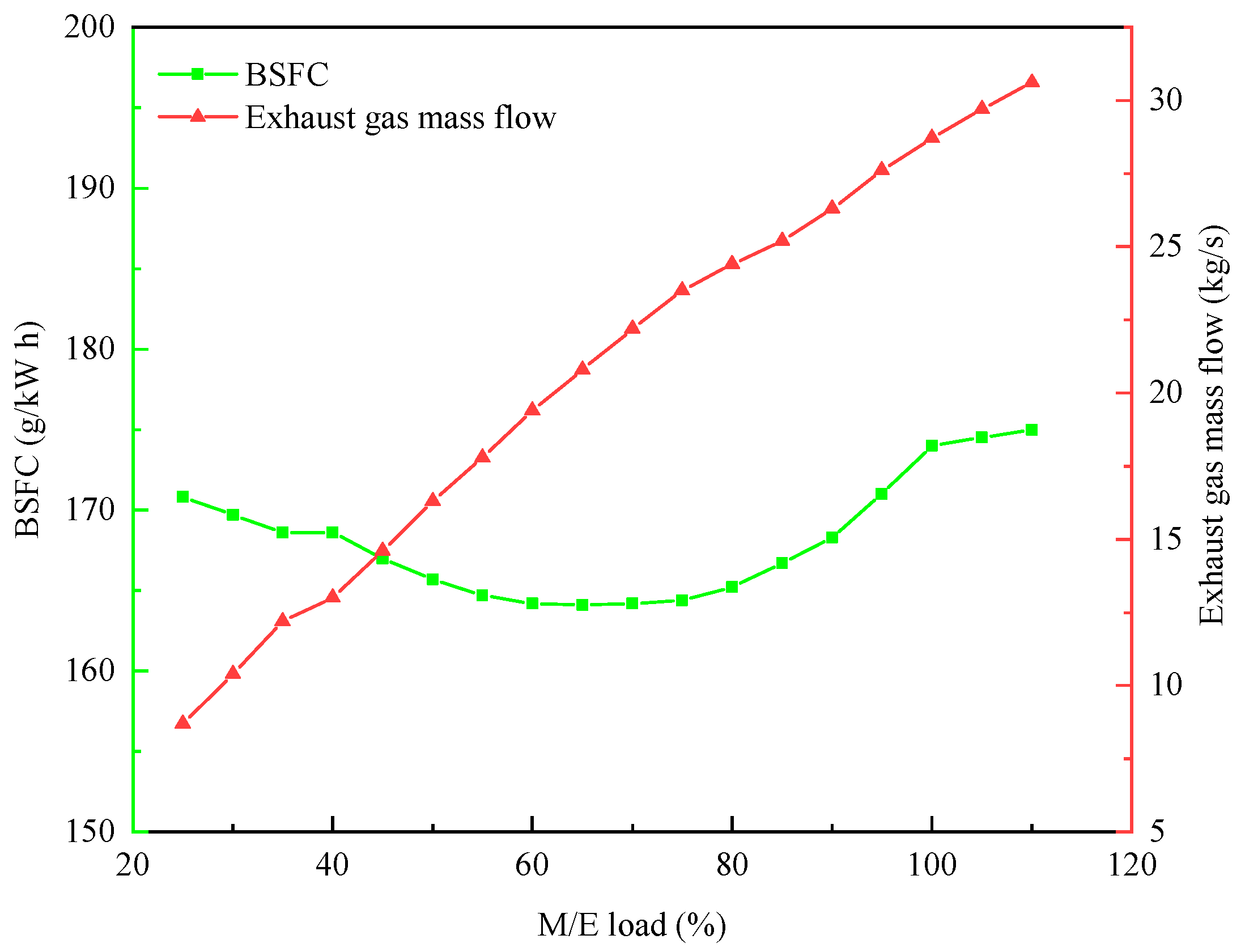

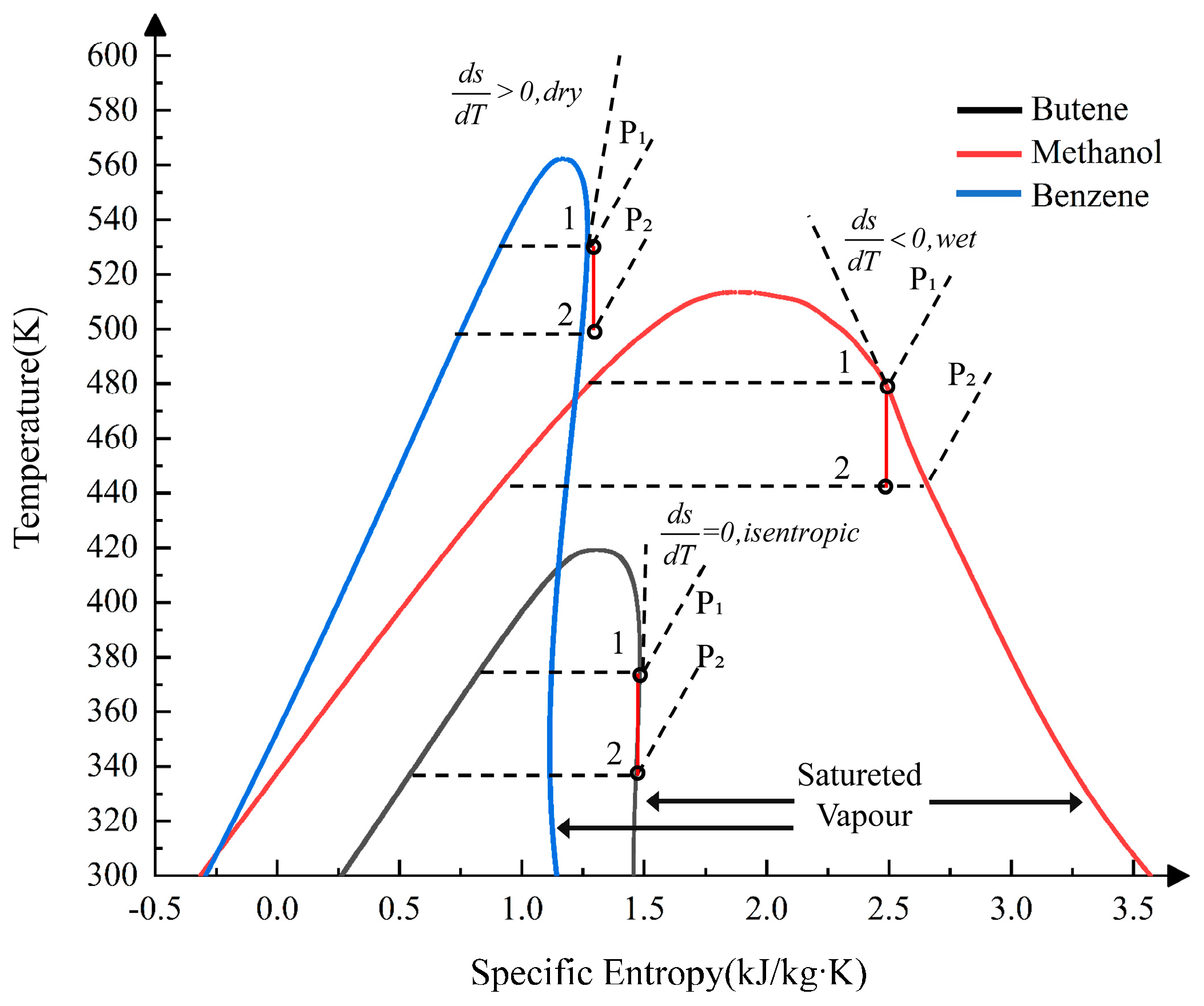
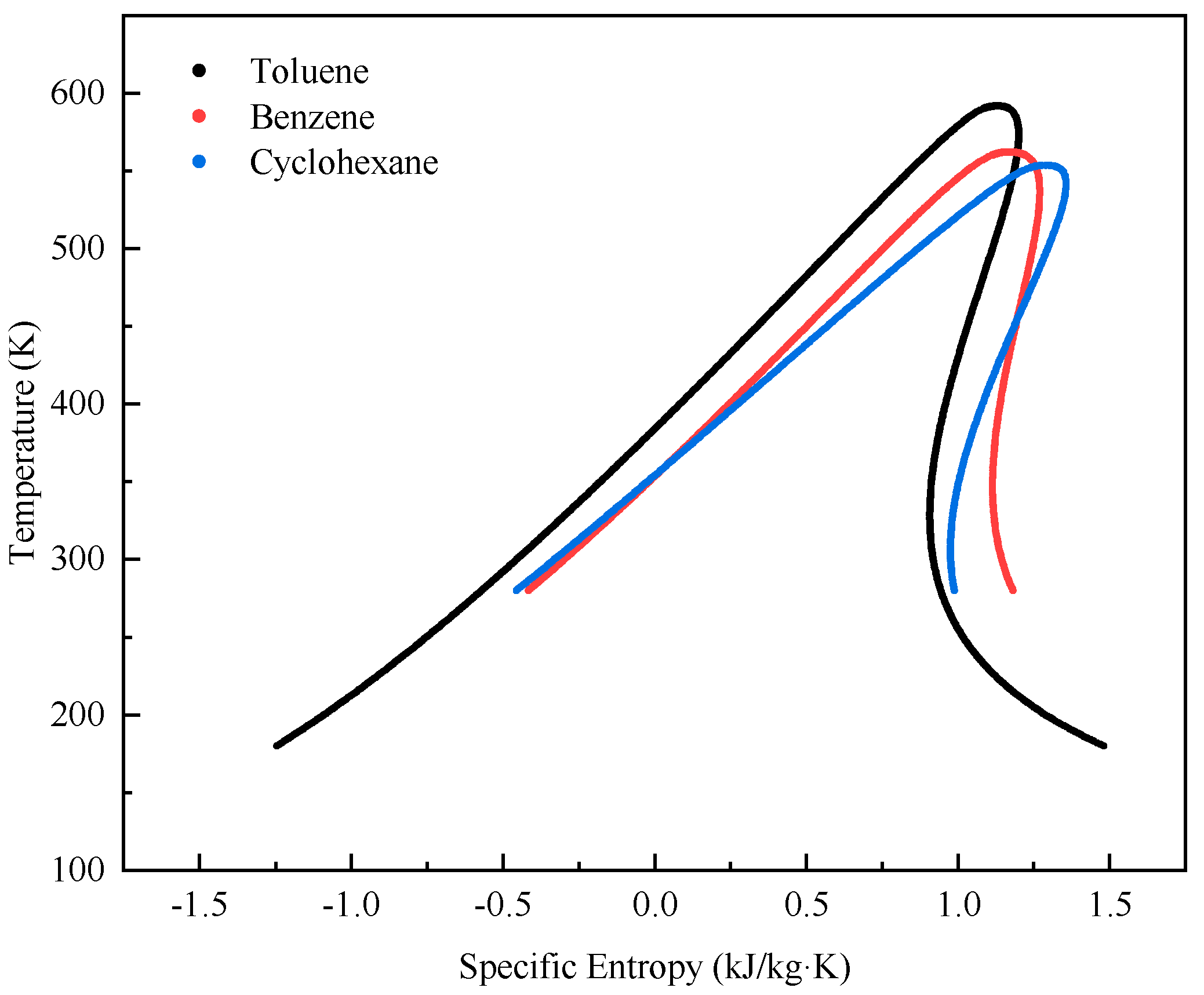
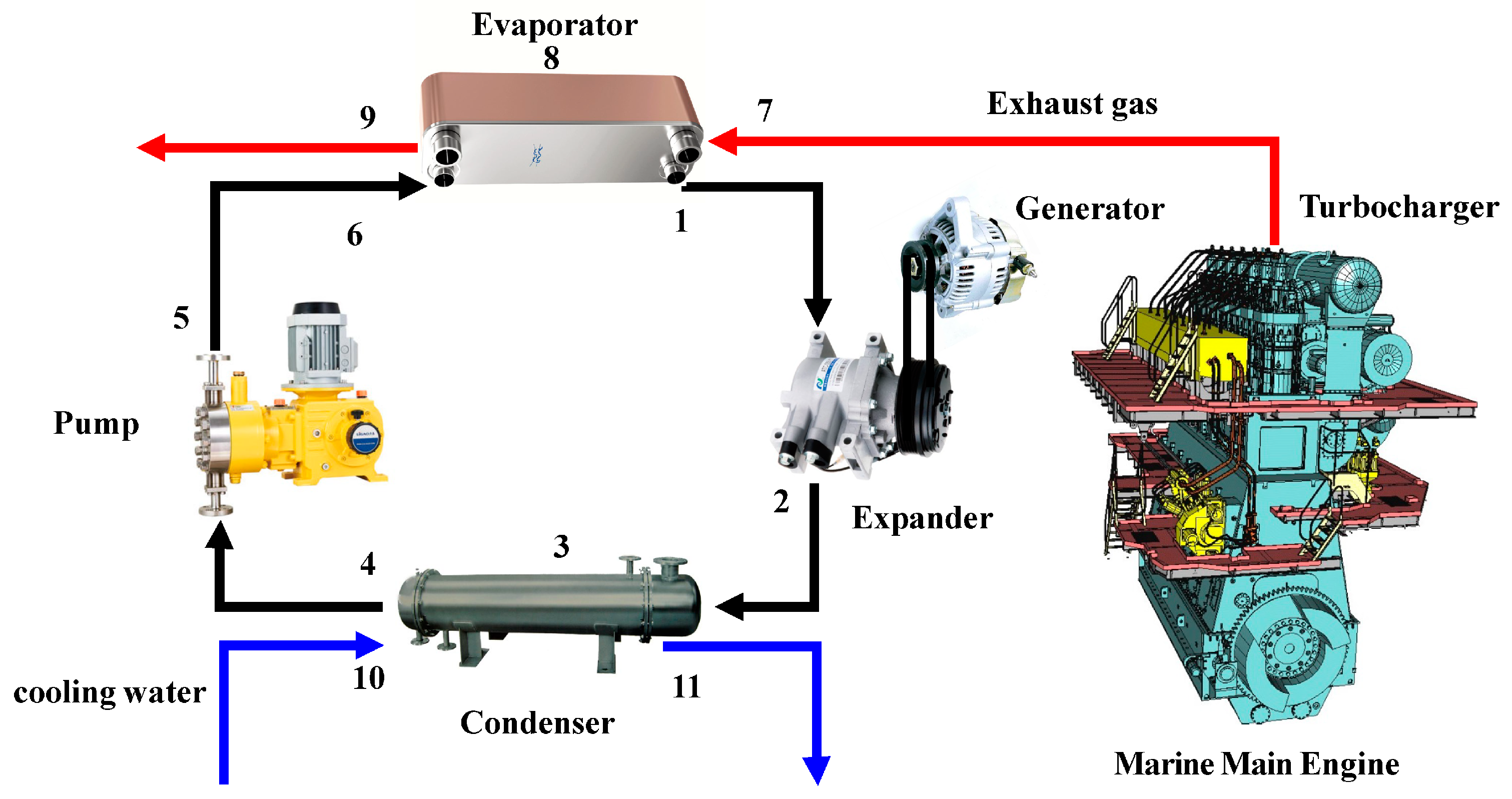
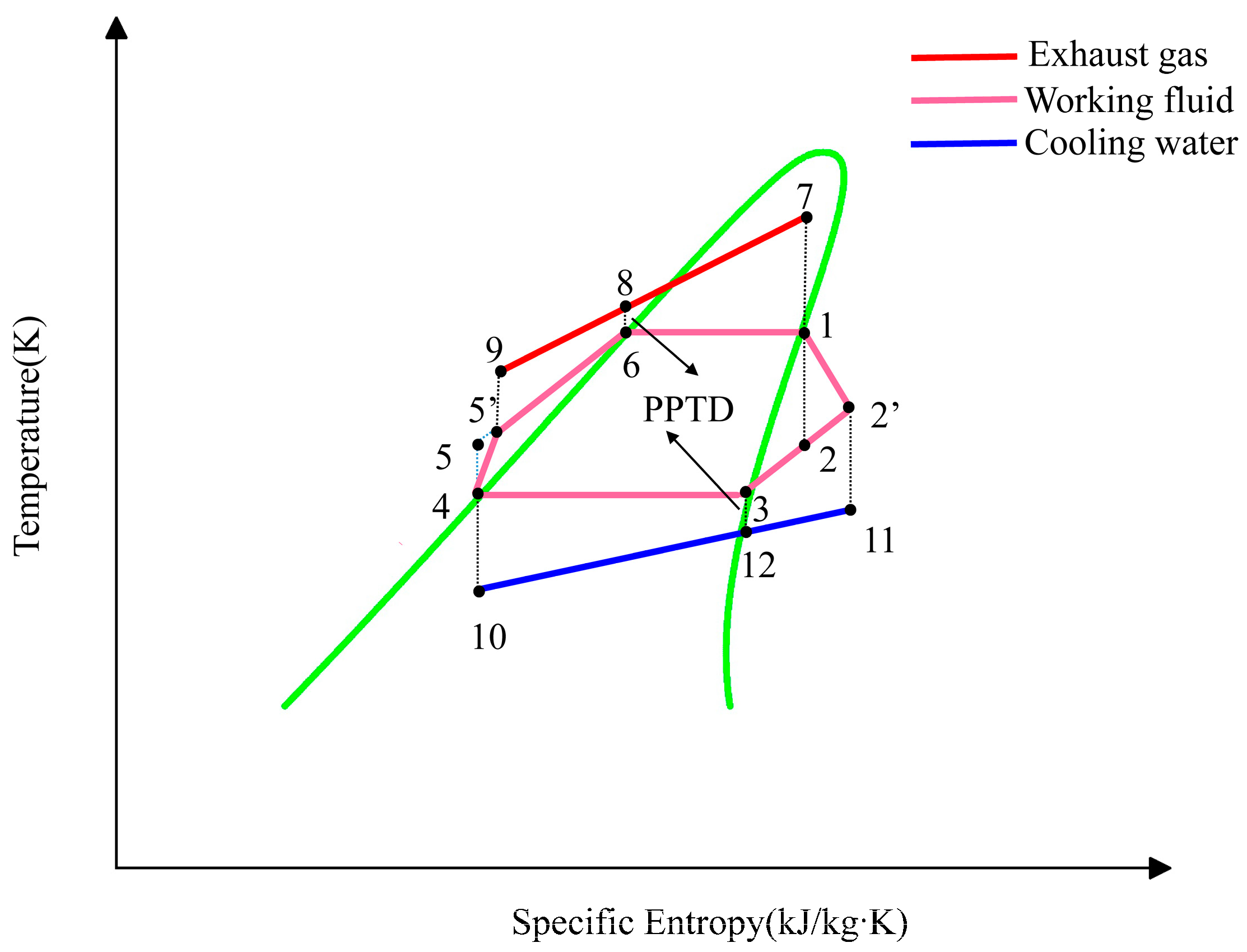
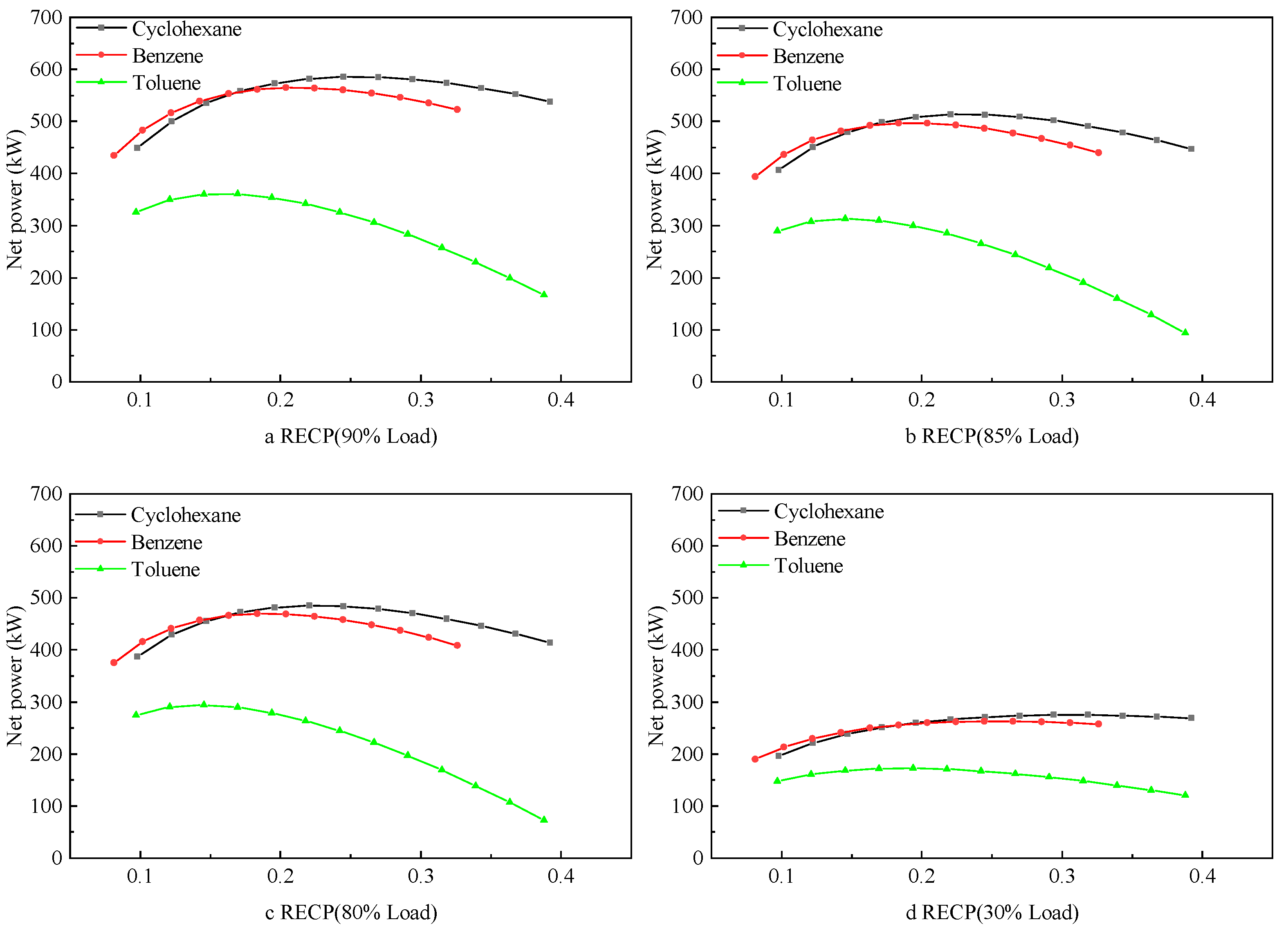
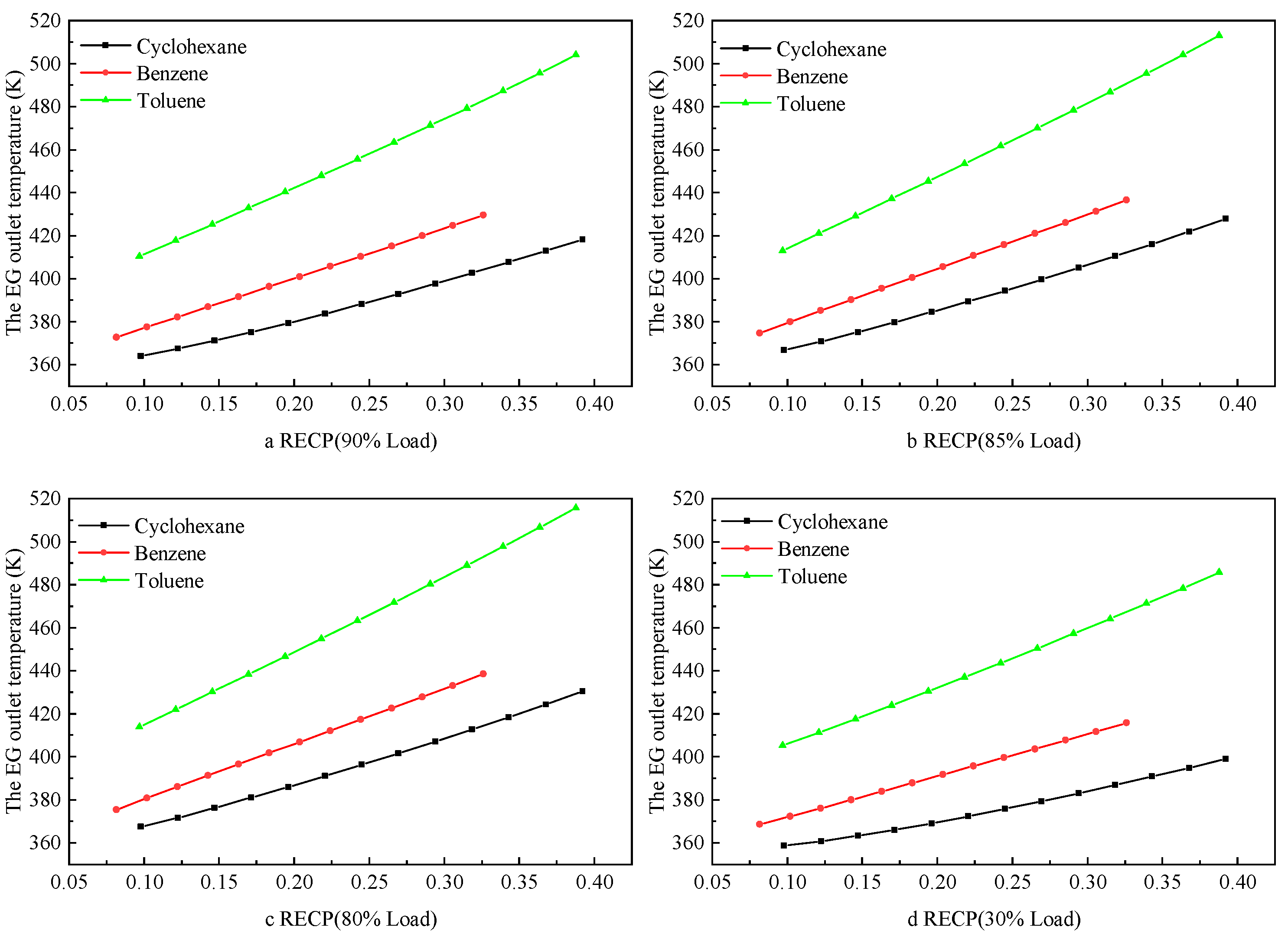



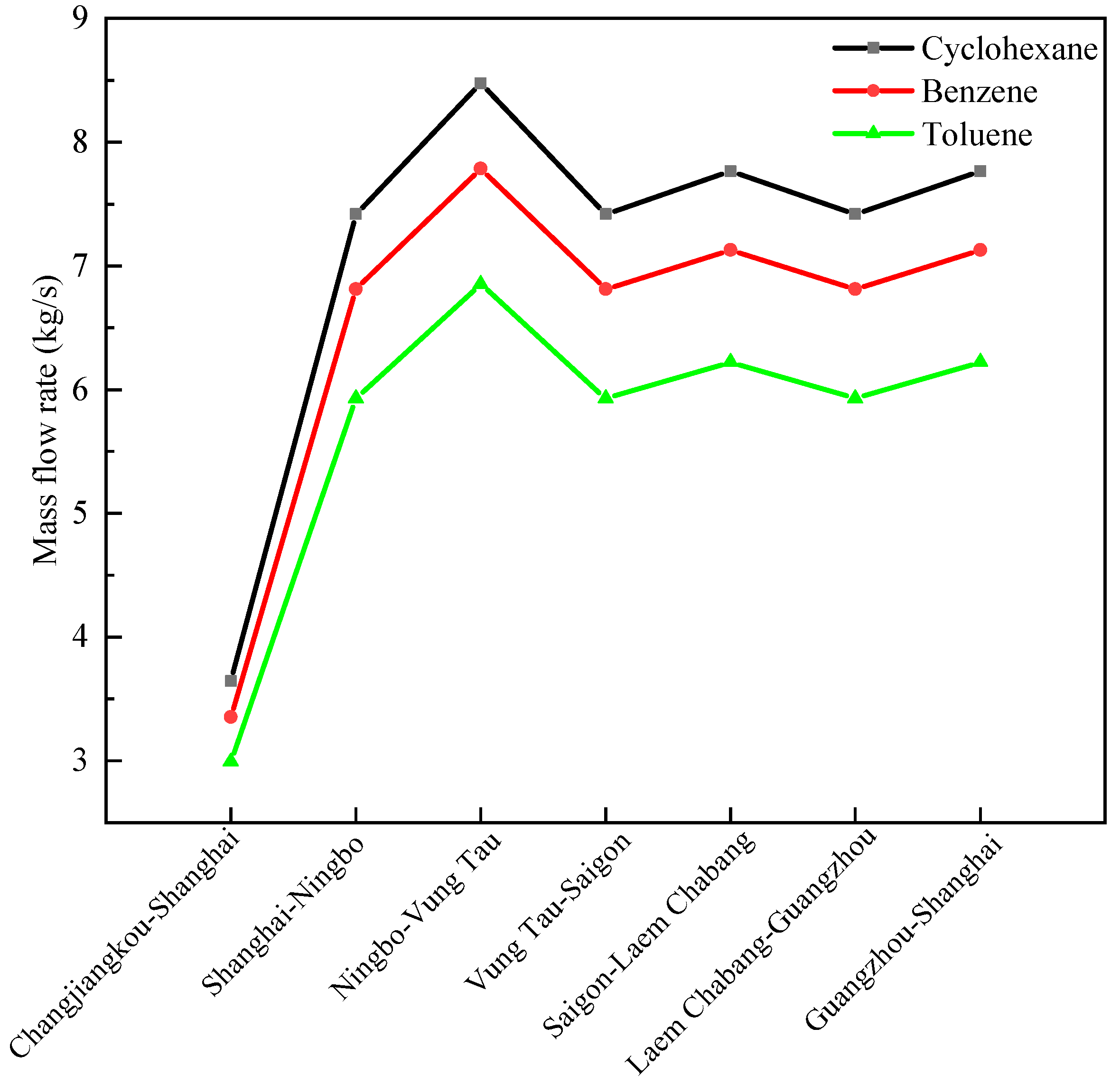

| M/E Information at 100% Load | |
|---|---|
| M/E type | 6RT-flex58T-E |
| Turbocharger type | A-165-L(ABB) |
| MCR Power (kW) | 14,100 |
| MCR Speed (rpm) | 105 |
| CSR Power (kW) | 11,985 |
| CSR Speed (rpm) | 99.5 |
| Piston Stroke (mm) | 2416 |
| Piston speed (m/s) | 8.5 |
| BSFC (g/kW h) | 174 |
| Scavenge air, mass flow (kg/s) | 28.1 |
| EG, mass flow (kg/s) | 28.7 |
| EG before the turbocharger, temperature (K) | 752.15 |
| EG after the turbocharger, temperature (K) | 559.15 |
| EG, density (kg/m3) | 0.641 |
| M/E Load (%) | M/E Power (kW) | Shaft Speed (rpm) | tEbT (K) | tEaT (K) | mExh (kg/s) |
|---|---|---|---|---|---|
| 110 | 15,510 | 108.4 | 778.15 | 571.15 | 30.6 |
| 105 | 14,805 | 106.7 | 765.15 | 565.15 | 29.7 |
| 100 | 14,100 | 105 | 752.15 | 559.15 | 28.7 |
| 95 | 13,395 | 103.2 | 735.15 | 551.15 | 27.6 |
| 90 | 12,690 | 101.4 | 718.15 | 543.15 | 26.3 |
| 85 | 11,985 | 99.5 | 704.15 | 536.15 | 25.2 |
| 80 | 11,280 | 97.5 | 696.15 | 534.15 | 24.4 |
| 75 | 10,575 | 95.4 | 689.15 | 532.15 | 23.5 |
| 70 | 9870 | 93.2 | 680.15 | 532.15 | 22.2 |
| 65 | 9165 | 91 | 671.15 | 532.15 | 20.8 |
| 60 | 8460 | 88.6 | 663.15 | 534.15 | 19.4 |
| 55 | 7755 | 86 | 657.15 | 539.15 | 17.8 |
| 50 | 7050 | 83.3 | 653.15 | 546.15 | 16.3 |
| 45 | 6345 | 80.5 | 651.15 | 556.15 | 14.6 |
| 40 | 5640 | 77.4 | 651.15 | 568.15 | 13 |
| 35 | 4935 | 74 | 618.15 | 544.15 | 12.2 |
| 30 | 4230 | 70.3 | 614.15 | 557.15 | 10.4 |
| 25 | 3525 | 66.1 | 608.15 | 567.15 | 8.7 |
| Name | Chemical Formula | GWP | ODP | Critical Pressure (kPa) | Critical Temperature (K) | Fluid Type |
|---|---|---|---|---|---|---|
| Toluene | C7H8 | 3 | 0 | 4126.3 | 591.75 | Dry |
| Benzene | C6H6 | ~20 | 0 | 4907.3 | 562.02 | Dry |
| Cyclohexane | C6H12 | ~20 | 0 | 4080.5 | 553.6 | Dry |
| Port | Voyage Time (h) | Shaft Speed (rpm) | M/E Load (%) | Fuel Consumption (g/kWh) | Power (kW) | EG Temperature (K) | EG Mass Flow (kg/s) |
|---|---|---|---|---|---|---|---|
| Changjiangkou | - | - | - | - | - | - | - |
| Shanghai | 28.9 | 70.3 | 30% | 169.7 | 4230 | 557.15 | 10.4 |
| Ningbo | 10.5 | 97.5 | 80% | 165.2 | 11,280 | 534.15 | 24.4 |
| Vung Tau | 104.4 | 101.4 | 90% | 168.3 | 12,690 | 543.15 | 26.3 |
| Saigon | 4.1 | 97.5 | 80% | 165.2 | 11,280 | 534.15 | 24.4 |
| Laem Chabang | 44 | 99.5 | 85% | 166.7 | 11,985 | 536.15 | 25.2 |
| Guangzhou | 110.3 | 97.5 | 80% | 165.2 | 11,280 | 534.15 | 24.4 |
| Shanghai | 66.7 | 99.5 | 85% | 166.7 | 11,985 | 536.15 | 25.2 |
| Parameters | Experimental Data | Simulation Data | Error |
|---|---|---|---|
| The isentropic efficiency of the expander | 0.8 | 0.8 | - |
| The isentropic efficiency of the pump | 0.8 | 0.8 | - |
| PPTD (K) | 6 | 6 | - |
| The EG mass flow rate (kg/h) | 7139 | 7139 | - |
| The EG inlet temperature (K) | 573.15 | 573.15 | - |
| The specific heat capacity of the EG (kJ/(kg·K)) | 1.1 | 1.089 | 1% |
| The Evaporation temperature (K) | 480.3 | 480.3 | - |
| The condensation temperature (K) | 355 | 355 | - |
| Net power (kW) | 64 | 65.47 | 2.2% |
| Thermal efficiency (%) | 14.8 | 15.25 | 2.9% |
| Mass flow (kg/s) | 0.8 | 0.77 | 3.7% |
Disclaimer/Publisher’s Note: The statements, opinions and data contained in all publications are solely those of the individual author(s) and contributor(s) and not of MDPI and/or the editor(s). MDPI and/or the editor(s) disclaim responsibility for any injury to people or property resulting from any ideas, methods, instructions or products referred to in the content. |
© 2023 by the authors. Licensee MDPI, Basel, Switzerland. This article is an open access article distributed under the terms and conditions of the Creative Commons Attribution (CC BY) license (https://creativecommons.org/licenses/by/4.0/).
Share and Cite
Lyu, L.; Kan, A.; Chen, W.; Zhang, Y.; Fu, B. Energy, Exergy and Environmental Analysis of ORC Waste Heat Recovery from Container Ship Exhaust Gases Based on Voyage Cycle. J. Mar. Sci. Eng. 2023, 11, 2029. https://doi.org/10.3390/jmse11102029
Lyu L, Kan A, Chen W, Zhang Y, Fu B. Energy, Exergy and Environmental Analysis of ORC Waste Heat Recovery from Container Ship Exhaust Gases Based on Voyage Cycle. Journal of Marine Science and Engineering. 2023; 11(10):2029. https://doi.org/10.3390/jmse11102029
Chicago/Turabian StyleLyu, Long, Ankang Kan, Wu Chen, Yuan Zhang, and Bingchun Fu. 2023. "Energy, Exergy and Environmental Analysis of ORC Waste Heat Recovery from Container Ship Exhaust Gases Based on Voyage Cycle" Journal of Marine Science and Engineering 11, no. 10: 2029. https://doi.org/10.3390/jmse11102029
APA StyleLyu, L., Kan, A., Chen, W., Zhang, Y., & Fu, B. (2023). Energy, Exergy and Environmental Analysis of ORC Waste Heat Recovery from Container Ship Exhaust Gases Based on Voyage Cycle. Journal of Marine Science and Engineering, 11(10), 2029. https://doi.org/10.3390/jmse11102029







